第一章 Rook安装
rook的版本大于1.3,不要使用目录创建集群,要使用单独的裸盘进行创建,也就是创建一个新的磁盘,挂载到宿主机,不进行格式化,直接使用即可。对于的磁盘节点配置如下:
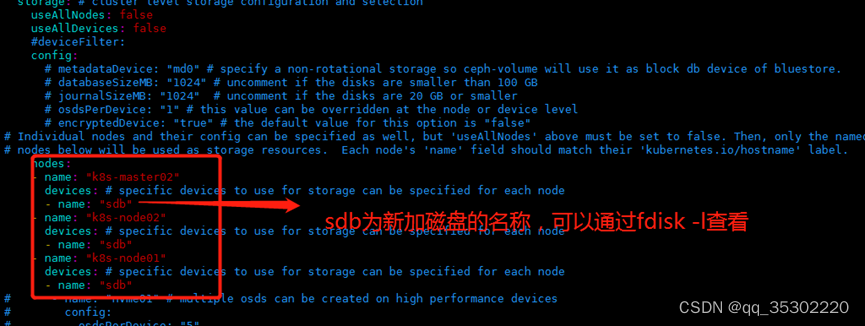
做这个实验需要高配置,每个节点配置不能低于2核4G
k8s 1.19以上版本,快照功能需要单独安装snapshot控制器
下载Rook安装文件
下载指定版本Rook
git clone --single-branch --branch v1.6.3 https://github.com/rook/rook.git
配置更改
cd rook/cluster/examples/kubernetes/ceph
修改Rook CSI镜像地址,原本的地址可能是gcr的镜像,但是gcr的镜像无法被国内访问,所以需要同步gcr的镜像到阿里云镜像仓库,文档版本已经完成同步,可以直接修改如下:
vim operator.yaml
将

改为:
ROOK_CSI_REGISTRAR_IMAGE: "registry.cn-beijing.aliyuncs.com/dotbalo/csi-node-driver-registrar:v2.0.1"
ROOK_CSI_RESIZER_IMAGE: "registry.cn-beijing.aliyuncs.com/dotbalo/csi-resizer:v1.0.1"
ROOK_CSI_PROVISIONER_IMAGE: "registry.cn-beijing.aliyuncs.com/dotbalo/csi-provisioner:v2.0.4"
ROOK_CSI_SNAPSHOTTER_IMAGE: "registry.cn-beijing.aliyuncs.com/dotbalo/csi-snapshotter:v4.0.0"
ROOK_CSI_ATTACHER_IMAGE: "registry.cn-beijing.aliyuncs.com/dotbalo/csi-attacher:v3.0.2"
如果是其他版本,需要自行同步,同步方法可以在网上找到相关文章。可以参考https://blog.csdn.net/sinat_35543900/article/details/103290782
还是operator文件,新版本rook默认关闭了自动发现容器的部署,可以找到ROOK_ENABLE_DISCOVERY_DAEMON改成true即可:

部署rook
1.6.3版本的部署步骤如下:
cd cluster/examples/kubernetes/ceph
kubectl create -f crds.yaml -f common.yaml -f operator.yaml
等待operator容器和discover容器启动
[root@k8s-master01 ceph]# kubectl -n rook-ceph get pod
NAME READY STATUS RESTARTS AGE
rook-ceph-operator-65965c66b5-q4529 1/1 Running 0 7m43s
rook-discover-7bjbn 1/1 Running 0 5m31s
rook-discover-dv4bn 1/1 Running 0 5m31s
rook-discover-gbln2 1/1 Running 0 5m31s
rook-discover-hlqrg 1/1 Running 0 5m31s
rook-discover-np7pb 1/1 Running 0 5m31s
第二章 创建ceph集群
配置更改
主要更改的是osd节点所在的位置:
cd cluster/examples/kubernetes/ceph
vim cluster.yaml
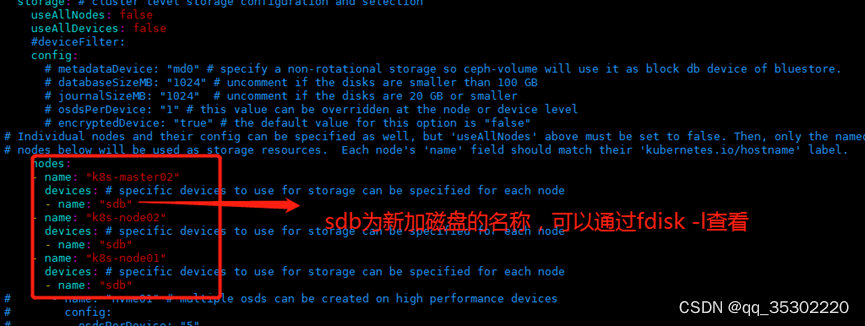
新版必须采用裸盘,即未格式化的磁盘。其中k8s-master02 k8s-node01 node02有新加的一个磁盘,可以通过lsblk -f查看新添加的磁盘名称。建议最少三个节点,否则后面的试验可能会出现问题
创建Ceph集群
kubectl create -f cluster.yaml
创建完成后,可以查看pod的状态:
[root@k8s-master01 ceph]# kubectl -n rook-ceph get pod
NAME READY STATUS RESTARTS AGE
csi-cephfsplugin-cp2s5 3/3 Running 0 27m
csi-cephfsplugin-h4wb5 3/3 Running 0 27m
csi-cephfsplugin-jznvn 3/3 Running 0 27m
csi-cephfsplugin-k9q28 3/3 Running 0 27m
csi-cephfsplugin-provisioner-574976878-f5n7c 6/6 Running 0 27m
csi-cephfsplugin-provisioner-574976878-p7vcx 6/6 Running 0 27m
csi-cephfsplugin-z2645 3/3 Running 0 27m
csi-rbdplugin-7fzmv 3/3 Running 0 27m
csi-rbdplugin-7xsrp 3/3 Running 0 27m
csi-rbdplugin-b9lqh 3/3 Running 0 27m
csi-rbdplugin-dx2jk 3/3 Running 0 27m
csi-rbdplugin-provisioner-884fb5b55-dm5dl 6/6 Running 0 27m
csi-rbdplugin-provisioner-884fb5b55-z4p49 6/6 Running 0 27m
csi-rbdplugin-x4snv 3/3 Running 0 27m
rook-ceph-crashcollector-k8s-master02-f9db7d85d-lltdp 1/1 Running 0 17m
rook-ceph-crashcollector-k8s-node01-747795874c-5cdz6 1/1 Running 0 17m
rook-ceph-crashcollector-k8s-node02-5d4867cfb8-n74wn 1/1 Running 0 17m
rook-ceph-mgr-a-77bf97745c-4hqpp 1/1 Running 0 17m
rook-ceph-mon-a-6d4444d6bf-jvlxw 1/1 Running 0 19m
rook-ceph-mon-b-68b66fd889-x28bf 1/1 Running 0 17m
rook-ceph-mon-c-54bb69686-v8ftf 1/1 Running 0 17m
rook-ceph-operator-65965c66b5-q4529 1/1 Running 0 50m
rook-ceph-osd-0-667c867b46-m8nnj 1/1 Running 0 17m
rook-ceph-osd-1-56784d575b-vm8mc 1/1 Running 0 17m
rook-ceph-osd-2-74f856bb8c-s2r69 1/1 Running 0 17m
rook-ceph-osd-prepare-k8s-master02-nf7qn 0/1 Completed 0 16m
rook-ceph-osd-prepare-k8s-node01-jkm6g 0/1 Completed 0 16m
rook-ceph-osd-prepare-k8s-node02-xr4rt 0/1 Completed 0 16m
rook-discover-7bjbn 1/1 Running 0 48m
rook-discover-dv4bn 1/1 Running 0 48m
rook-discover-gbln2 1/1 Running 0 48m
rook-discover-hlqrg 1/1 Running 0 48m
rook-discover-np7pb 1/1 Running 0 48m
需要注意的是,osd-x的容器必须是存在的,且是正常的。如果上述Pod均正常,则认为集群安装成功。
更多配置:https://rook.io/docs/rook/v1.6/ceph-cluster-crd.html
安装ceph snapshot控制器
k8s 1.19版本以上需要单独安装snapshot控制器,才能完成pvc的快照功能,所以在此提前安装下
snapshot控制器的部署在集群安装时的k8s-ha-install项目中,需要切换到1.20.x分支:
cd /root/k8s-ha-install/
git checkout manual-installation-v1.20.x
创建snapshot controller:
kubectl create -f snapshotter/ -n kube-system
[root@k8s-master01 k8s-ha-install]# kubectl get po -n kube-system -l app=snapshot-controller
NAME READY STATUS RESTARTS AGE
snapshot-controller-0 1/1 Running 0 51s
具体文档:https://rook.io/docs/rook/v1.6/ceph-csi-snapshot.html
第三章 安装ceph客户端工具
[root@k8s-master01 k8s-ha-install]# cd /rook/cluster/examples/kubernetes/ceph
[root@k8s-master01 ceph]# kubectl create -f toolbox.yaml -n rook-ceph
deployment.apps/rook-ceph-tools created
待容器Running后,即可执行相关命令
[root@k8s-master01 ceph]# kubectl get po -n rook-ceph -l app=rook-ceph-tools
NAME READY STATUS RESTARTS AGE
rook-ceph-tools-fc5f9586c-wq72t 1/1 Running 0 38s
[root@k8s-master01 ceph]# kubectl -n rook-ceph exec -it deploy/rook-ceph-tools -- bash
[root@rook-ceph-tools-fc5f9586c-wq72t /]# ceph status
cluster:
id: b23b3611-f332-40a7-bd4b-f555458ce160
health: HEALTH_WARN
mons are allowing insecure global_id reclaim
services:
mon: 3 daemons, quorum a,b,c (age 7m)
mgr: a(active, since 7m)
osd: 3 osds: 3 up (since 7m), 3 in (since 10h)
data:
pools: 1 pools, 1 pgs
objects: 0 objects, 0 B
usage: 3.0 GiB used, 57 GiB / 60 GiB avail
pgs: 1 active+clean
[root@rook-ceph-tools-fc5f9586c-wq72t /]# ceph osd status
ID HOST USED AVAIL WR OPS WR DATA RD OPS RD DATA STATE
0 k8s-node01 1027M 18.9G 0 0 0 0 exists,up
1 k8s-node02 1027M 18.9G 0 0 0 0 exists,up
2 k8s-master02 1027M 18.9G 0 0 0 0 exists,up
[root@rook-ceph-tools-fc5f9586c-wq72t /]# ceph df
--- RAW STORAGE ---
CLASS SIZE AVAIL USED RAW USED %RAW USED
hdd 60 GiB 57 GiB 11 MiB 3.0 GiB 5.02
TOTAL 60 GiB 57 GiB 11 MiB 3.0 GiB 5.02
--- POOLS ---
POOL ID PGS STORED OBJECTS USED %USED MAX AVAIL
device_health_metrics 1 1 0 B 0 0 B 0 18 GiB
第四章 Ceph dashboard
参考官网
The simplest way to expose the service in minikube or similar environment is using the NodePort to open a port on the VM that can be accessed by the host. To create a service with the NodePort, save this yaml as dashboard-external-https.yaml.
The simplest way to expose the service in minikube or similar environment is using the NodePort to open a port on the VM that can be accessed by the host. To create a service with the NodePort, save this yaml as dashboard-external-https.yaml.
在minikube或类似环境中公开服务的最简单方法是使用NodePort在VM上打开主机可以访问的端口。要使用NodePort创建服务,请将此yaml保存为dashboard-external-https.yaml。
apiVersion: v1
kind: Service
metadata:
name: rook-ceph-mgr-dashboard-external-https
namespace: rook-ceph
labels:
app: rook-ceph-mgr
rook_cluster: rook-ceph
spec:
ports:
- name: dashboard
port: 8443
protocol: TCP
targetPort: 8443
selector:
app: rook-ceph-mgr
rook_cluster: rook-ceph
sessionAffinity: None
type: NodePort
创建服务
kubectl create -f dashboard-external-https.yaml
查看服务
[root@k8s-master01 ceph]# kubectl -n rook-ceph get service
NAME TYPE CLUSTER-IP EXTERNAL-IP PORT(S) AGE
csi-cephfsplugin-metrics ClusterIP 192.168.114.108 <none> 8080/TCP,8081/TCP 11h
csi-rbdplugin-metrics ClusterIP 192.168.214.223 <none> 8080/TCP,8081/TCP 11h
rook-ceph-mgr ClusterIP 192.168.5.9 <none> 9283/TCP 11h
rook-ceph-mgr-dashboard ClusterIP 192.168.144.39 <none> 8443/TCP 11h
rook-ceph-mgr-dashboard-external-https NodePort 192.168.195.164 <none> 8443:31250/TCP 8m53s
rook-ceph-mon-a ClusterIP 192.168.71.28 <none> 6789/TCP,3300/TCP 11h
rook-ceph-mon-b ClusterIP 192.168.137.117 <none> 6789/TCP,3300/TCP 11h
rook-ceph-mon-c ClusterIP 192.168.245.155 <none> 6789/TCP,3300/TCP 11h
访问
账号:admin
密码:通过命令获取
kubectl -n rook-ceph get secret rook-ceph-dashboard-password -o jsonpath="{['data']['password']}" | base64 --decode && echo
通过安装ceph的任意节点ip+端口号进行访问
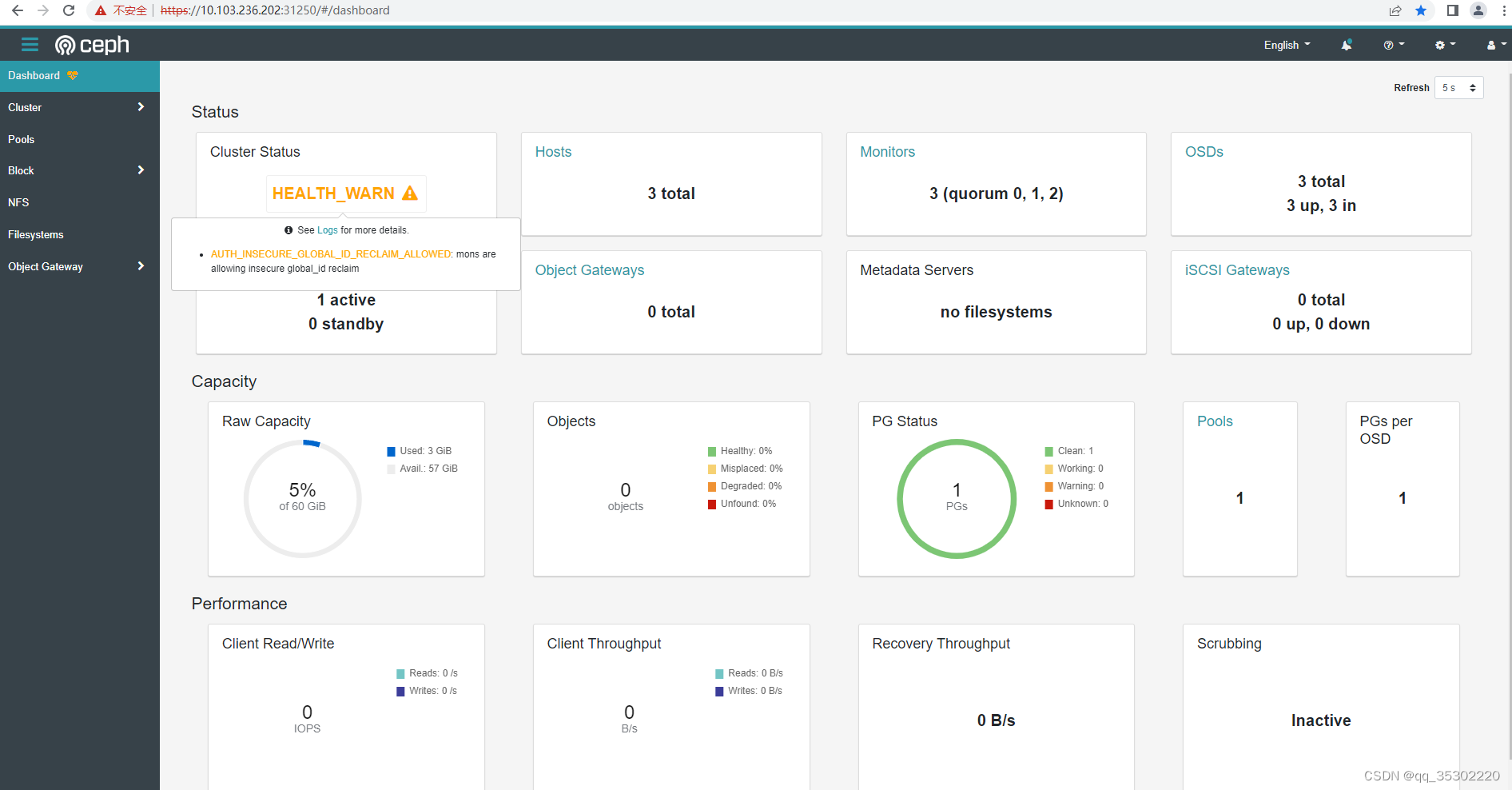
警告解决:https://docs.ceph.com/en/octopus/rados/operations/health-checks/
ceph -s出现mon is allowing insecure global_id reclaim的解决办法
需要禁用掉不安全的模式,使用如下命令
ceph config set mon auth_allow_insecure_global_id_reclaim false
第五章 ceph块存储的使用
块存储一般用于一个Pod挂载一块存储使用,相当于一个服务器新挂了一个盘,只给一个应用使用。
参考文档
创建StorageClass和ceph的存储池
[root@k8s-master01 ceph]# pwd
/rook/cluster/examples/kubernetes/ceph
[root@k8s-master01 ceph]# vim csi/rbd/storageclass.yaml
因为是试验环境,所以将副本数设置成了2(不能设置为1),生产环境最少为3,且要小于等于osd的数量
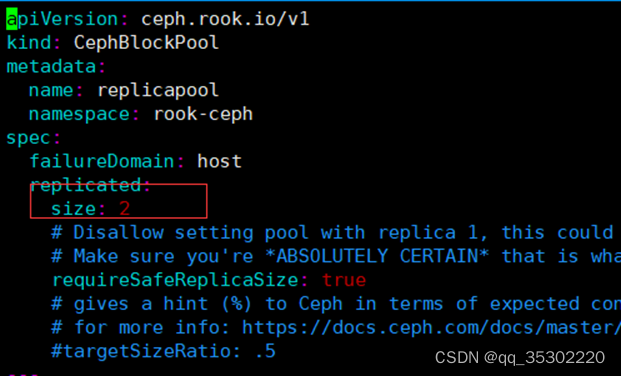
创建StorageClass和存储池:
[root@k8s-master01 ceph]# kubectl create -f csi/rbd/storageclass.yaml -n rook-ceph
cephblockpool.ceph.rook.io/replicapool created
storageclass.storage.k8s.io/rook-ceph-block created
查看创建的cephblockpool和storageClass
StorageClass没有namespace隔离性
[root@k8s-master01 ceph]# kubectl get cephblockpool -n rook-ceph
NAME AGE
replicapool 57s
[root@k8s-master01 ceph]# kubectl get sc
NAME PROVISIONER RECLAIMPOLICY VOLUMEBINDINGMODE ALLOWVOLUMEEXPANSION AGE
rook-ceph-block rook-ceph.rbd.csi.ceph.com Delete Immediate true 74s
此时可以在ceph dashboard查看到改Pool,如果没有显示说明没有创建成功

挂载测试
创建一个MySQL服务
[root@k8s-master01 ceph]# cd /rook/cluster/examples/kubernetes
[root@k8s-master01 kubernetes]# kubectl create -f mysql.yaml
service/wordpress-mysql created
persistentvolumeclaim/mysql-pv-claim created
deployment.apps/wordpress-mysql created
该文件有一段pvc的配置
[root@k8s-master01 kubernetes]# cat mysql.yaml
apiVersion: v1
kind: Service
metadata:
name: wordpress-mysql
labels:
app: wordpress
spec:
ports:
- port: 3306
selector:
app: wordpress
tier: mysql
clusterIP: None
---
apiVersion: v1
kind: PersistentVolumeClaim
metadata:
name: mysql-pv-claim
labels:
app: wordpress
spec:
storageClassName: rook-ceph-block
accessModes:
- ReadWriteOnce
resources:
requests:
storage: 20Gi
---
apiVersion: apps/v1
kind: Deployment
metadata:
name: wordpress-mysql
labels:
app: wordpress
tier: mysql
spec:
selector:
matchLabels:
app: wordpress
tier: mysql
strategy:
type: Recreate
template:
metadata:
labels:
app: wordpress
tier: mysql
spec:
containers:
- image: mysql:5.6
name: mysql
env:
- name: MYSQL_ROOT_PASSWORD
value: changeme
ports:
- containerPort: 3306
name: mysql
volumeMounts:
- name: mysql-persistent-storage
mountPath: /var/lib/mysql
volumes:
- name: mysql-persistent-storage
persistentVolumeClaim:
claimName: mysql-pv-claim
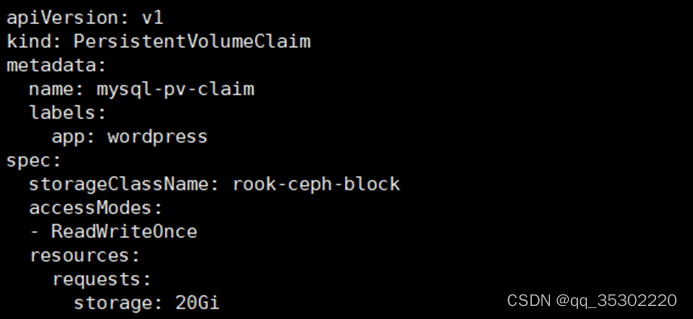
pvc会连接刚才创建的storageClass,然后动态创建pv,然后连接到ceph创建对应的存储,
之后创建pvc只需要指定storageClassName为刚才创建的StorageClass名称即可连接到rook的ceph。
如果是statefulset,只需要将volumeTemplateClaim里面的Claim名称改为StorageClass名称即可动态创建Pod
其中MySQL deployment的volumes配置挂载了该pvc:
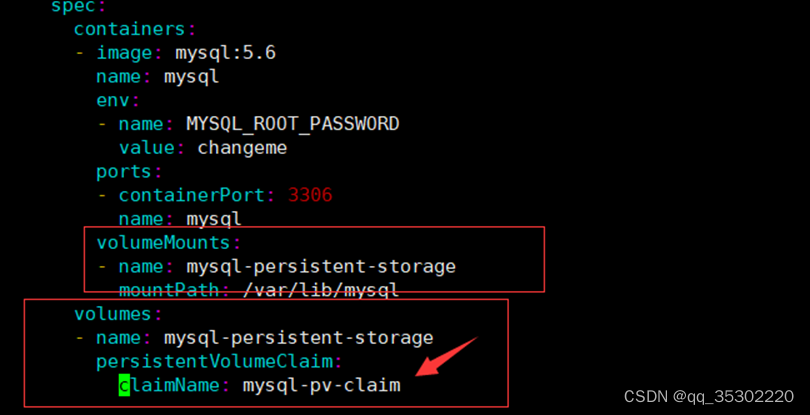
claimName为pvc的名称
因为MySQL的数据不能多个MySQL实例连接同一个存储,所以一般只能用块存储。相当于新加了一块盘给MySQL使用。
创建完成后可以查看创建的pvc和pv
[root@k8s-master01 kubernetes]# kubectl get pvc
NAME STATUS VOLUME CAPACITY ACCESS MODES STORAGECLASS AGE
mysql-pv-claim Bound pvc-7d7668d8-8d51-4456-aa2e-bedc18c251fd 20Gi RWO rook-ceph-block 39m
[root@k8s-master01 kubernetes]# kubectl get pv
NAME CAPACITY ACCESS MODES RECLAIM POLICY STATUS CLAIM STORAGECLASS REASON AGE
pvc-7d7668d8-8d51-4456-aa2e-bedc18c251fd 20Gi RWO Delete Bound default/mysql-pv-claim rook-ceph-block 39m
此时在ceph dashboard上面也可以查看到对应的image

StatefulSet · volumeClaimTemplates
apiVersion: v1
kind: Service
metadata:
name: nginx
labels:
app: nginx
spec:
ports:
- port: 80
name: web
clusterIP: None
selector:
app: nginx
---
apiVersion: apps/v1
kind: StatefulSet
metadata:
name: web
spec:
selector:
matchLabels:
app: nginx # has to match .spec.template.metadata.labels
serviceName: "nginx"
replicas: 3 # by default is 1
template:
metadata:
labels:
app: nginx # has to match .spec.selector.matchLabels
spec:
terminationGracePeriodSeconds: 10
containers:
- name: nginx
image: nginx
ports:
- containerPort: 80
name: web
volumeMounts:
- name: www
mountPath: /usr/share/nginx/html
volumeClaimTemplates:
- metadata:
name: www
spec:
accessModes: [ "ReadWriteOnce" ]
storageClassName: "rook-ceph-block"
resources:
requests:
storage: 1Gi
第六章 共享文件系统的使用
共享文件系统一般用于多个Pod共享一个存储
官方文档
创建共享类型的文件系统
[root@k8s-master01 kubernetes]# cd /rook/cluster/examples/kubernetes/ceph
[root@k8s-master01 ceph]# cat filesystem.yaml
#################################################################################################################
# Create a filesystem with settings with replication enabled for a production environment.
# A minimum of 3 OSDs on different nodes are required in this example.
# kubectl create -f filesystem.yaml
#################################################################################################################
apiVersion: ceph.rook.io/v1
kind: CephFilesystem
metadata:
name: myfs
namespace: rook-ceph # namespace:cluster
spec:
# The metadata pool spec. Must use replication.
metadataPool:
replicated:
size: 3
requireSafeReplicaSize: true
parameters:
# Inline compression mode for the data pool
# Further reference: https://docs.ceph.com/docs/nautilus/rados/configuration/bluestore-config-ref/#inline-compression
compression_mode:
none
# gives a hint (%) to Ceph in terms of expected consumption of the total cluster capacity of a given pool
# for more info: https://docs.ceph.com/docs/master/rados/operations/placement-groups/#specifying-expected-pool-size
#target_size_ratio: ".5"
# The list of data pool specs. Can use replication or erasure coding.
dataPools:
- failureDomain: host
replicated:
size: 3
# Disallow setting pool with replica 1, this could lead to data loss without recovery.
# Make sure you're *ABSOLUTELY CERTAIN* that is what you want
requireSafeReplicaSize: true
parameters:
# Inline compression mode for the data pool
# Further reference: https://docs.ceph.com/docs/nautilus/rados/configuration/bluestore-config-ref/#inline-compression
compression_mode:
none
# gives a hint (%) to Ceph in terms of expected consumption of the total cluster capacity of a given pool
# for more info: https://docs.ceph.com/docs/master/rados/operations/placement-groups/#specifying-expected-pool-size
#target_size_ratio: ".5"
# Whether to preserve filesystem after CephFilesystem CRD deletion
preserveFilesystemOnDelete: true
# The metadata service (mds) configuration
metadataServer:
# The number of active MDS instances
activeCount: 1
# Whether each active MDS instance will have an active standby with a warm metadata cache for faster failover.
# If false, standbys will be available, but will not have a warm cache.
activeStandby: true
# The affinity rules to apply to the mds deployment
placement:
# nodeAffinity:
# requiredDuringSchedulingIgnoredDuringExecution:
# nodeSelectorTerms:
# - matchExpressions:
# - key: role
# operator: In
# values:
# - mds-node
# topologySpreadConstraints:
# tolerations:
# - key: mds-node
# operator: Exists
# podAffinity:
podAntiAffinity:
requiredDuringSchedulingIgnoredDuringExecution:
- labelSelector:
matchExpressions:
- key: app
operator: In
values:
- rook-ceph-mds
# topologyKey: kubernetes.io/hostname will place MDS across different hosts
topologyKey: kubernetes.io/hostname
preferredDuringSchedulingIgnoredDuringExecution:
- weight: 100
podAffinityTerm:
labelSelector:
matchExpressions:
- key: app
operator: In
values:
- rook-ceph-mds
# topologyKey: */zone can be used to spread MDS across different AZ
# Use <topologyKey: failure-domain.beta.kubernetes.io/zone> in k8s cluster if your cluster is v1.16 or lower
# Use <topologyKey: topology.kubernetes.io/zone> in k8s cluster is v1.17 or upper
topologyKey: topology.kubernetes.io/zone
# A key/value list of annotations
annotations:
# key: value
# A key/value list of labels
labels:
# key: value
resources:
# The requests and limits set here, allow the filesystem MDS Pod(s) to use half of one CPU core and 1 gigabyte of memory
# limits:
# cpu: "500m"
# memory: "1024Mi"
# requests:
# cpu: "500m"
# memory: "1024Mi"
# priorityClassName: my-priority-class
mirroring:
enabled: false
[root@k8s-master01 ceph]# kubectl create -f filesystem.yaml
cephfilesystem.ceph.rook.io/myfs created
创建完成后会启动mds容器,需要等待启动后才可进行创建pv
[root@k8s-master01 ceph]# kubectl -n rook-ceph get pod -l app=rook-ceph-mds
NAME READY STATUS RESTARTS AGE
rook-ceph-mds-myfs-a-5c4fbfb9bd-xfhpw 1/1 Running 0 33s
rook-ceph-mds-myfs-b-678b4976d6-d8f9p 1/1 Running 0 32s
也可以在ceph dashboard上面查看状态
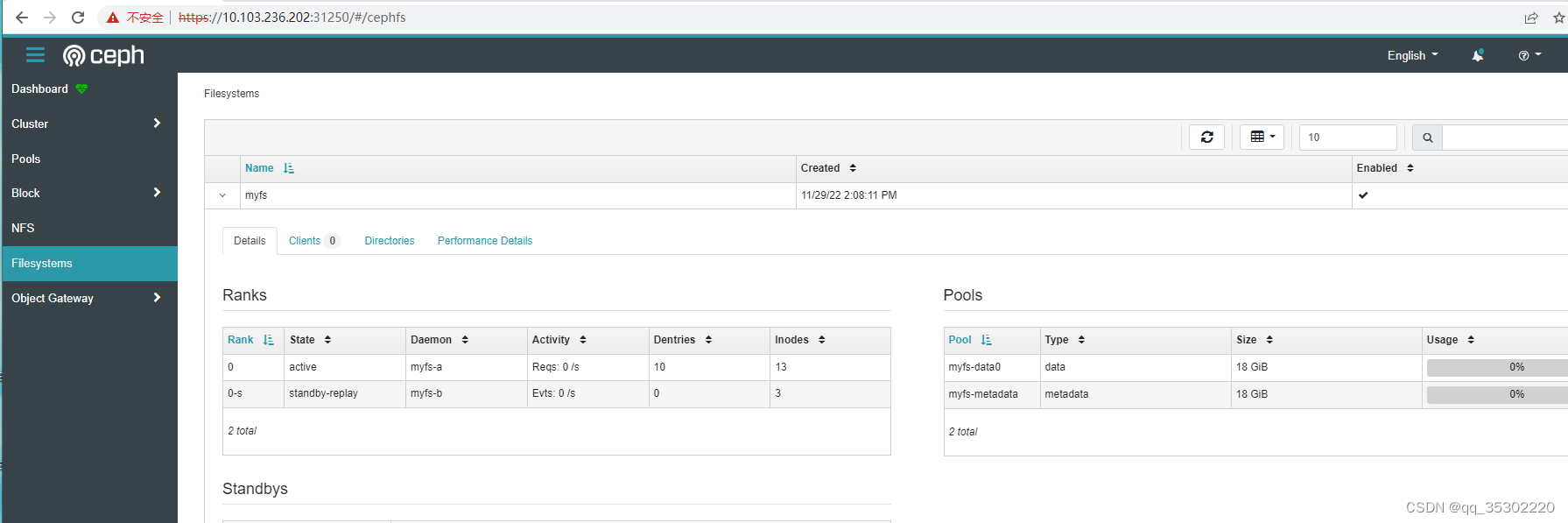
创建共享类型文件系统的StorageClass
[root@k8s-master01 ceph]# cd /rook/cluster/examples/kubernetes/ceph/csi/cephfs
[root@k8s-master01 cephfs]# cat storageclass.yaml
apiVersion: storage.k8s.io/v1
kind: StorageClass
metadata:
name: rook-cephfs
provisioner: rook-ceph.cephfs.csi.ceph.com # driver:namespace:operator
parameters:
# clusterID is the namespace where operator is deployed.
clusterID: rook-ceph # namespace:cluster
# CephFS filesystem name into which the volume shall be created
fsName: myfs
# Ceph pool into which the volume shall be created
# Required for provisionVolume: "true"
pool: myfs-data0
# The secrets contain Ceph admin credentials. These are generated automatically by the operator
# in the same namespace as the cluster.
csi.storage.k8s.io/provisioner-secret-name: rook-csi-cephfs-provisioner
csi.storage.k8s.io/provisioner-secret-namespace: rook-ceph # namespace:cluster
csi.storage.k8s.io/controller-expand-secret-name: rook-csi-cephfs-provisioner
csi.storage.k8s.io/controller-expand-secret-namespace: rook-ceph # namespace:cluster
csi.storage.k8s.io/node-stage-secret-name: rook-csi-cephfs-node
csi.storage.k8s.io/node-stage-secret-namespace: rook-ceph # namespace:cluster
# (optional) The driver can use either ceph-fuse (fuse) or ceph kernel client (kernel)
# If omitted, default volume mounter will be used - this is determined by probing for ceph-fuse
# or by setting the default mounter explicitly via --volumemounter command-line argument.
# mounter: kernel
reclaimPolicy: Delete
allowVolumeExpansion: true
mountOptions:
# uncomment the following line for debugging
#- debug
[root@k8s-master01 cephfs]# kubectl create -f storageclass.yaml
storageclass.storage.k8s.io/rook-cephfs created
之后将pvc的storageClassName设置成rook-cephfs即可创建共享文件类型的存储,类似于NFS,可以给多个Pod共享数据。
挂载测试
[root@k8s-master01 cephfs]# pwd
/rook/cluster/examples/kubernetes/ceph/csi/cephfs
[root@k8s-master01 cephfs]# ls
kube-registry.yaml pod.yaml pvc-clone.yaml pvc-restore.yaml pvc.yaml snapshotclass.yaml snapshot.yaml storageclass.yaml
[root@k8s-master01 cephfs]# cat kube-registry.yaml
apiVersion: v1
kind: PersistentVolumeClaim
metadata:
name: cephfs-pvc
namespace: kube-system
spec:
accessModes:
- ReadWriteMany
resources:
requests:
storage: 1Gi
storageClassName: rook-cephfs
---
apiVersion: apps/v1
kind: Deployment
metadata:
name: kube-registry
namespace: kube-system
labels:
k8s-app: kube-registry
kubernetes.io/cluster-service: "true"
spec:
replicas: 3
selector:
matchLabels:
k8s-app: kube-registry
template:
metadata:
labels:
k8s-app: kube-registry
kubernetes.io/cluster-service: "true"
spec:
containers:
- name: registry
image: registry:2
imagePullPolicy: Always
resources:
limits:
cpu: 100m
memory: 100Mi
env:
# Configuration reference: https://docs.docker.com/registry/configuration/
- name: REGISTRY_HTTP_ADDR
value: :5000
- name: REGISTRY_HTTP_SECRET
value: "Ple4seCh4ngeThisN0tAVerySecretV4lue"
- name: REGISTRY_STORAGE_FILESYSTEM_ROOTDIRECTORY
value: /var/lib/registry
volumeMounts:
- name: image-store
mountPath: /var/lib/registry
ports:
- containerPort: 5000
name: registry
protocol: TCP
livenessProbe:
httpGet:
path: /
port: registry
readinessProbe:
httpGet:
path: /
port: registry
volumes:
- name: image-store
persistentVolumeClaim:
claimName: cephfs-pvc
readOnly: false
[root@k8s-master01 cephfs]# kubectl create -f kube-registry.yaml
persistentvolumeclaim/cephfs-pvc created
deployment.apps/kube-registry created
查看创建的pvc和pod
[root@k8s-master01 cephfs]# kubectl get po -n kube-system -l k8s-app=kube-registry
NAME READY STATUS RESTARTS AGE
kube-registry-5d6d8877f7-ngp2x 1/1 Running 0 34s
kube-registry-5d6d8877f7-q7l8p 0/1 ContainerCreating 0 34s
kube-registry-5d6d8877f7-qmtqv 0/1 ContainerCreating 0 34s
[root@k8s-master01 cephfs]# kubectl get pvc -n kube-system
NAME STATUS VOLUME CAPACITY ACCESS MODES STORAGECLASS AGE
cephfs-pvc Bound pvc-6b08e697-354f-473d-9423-459e154e3d46 1Gi RWX rook-cephfs 58s
- 注意claimName为pvc的名称。
- 此时一共创建了三个Pod,这三个Pod共用了一个存储,挂载到了/var/lib/registry,该目录三个容器共享数据。
Nginx挂载测试
apiVersion: v1
kind: Service
metadata:
name: nginx
labels:
app: nginx
spec:
ports:
- port: 80
name: web
selector:
app: nginx
type: ClusterIP
---
kind: PersistentVolumeClaim
apiVersion: v1
metadata:
name: nginx-share-pvc
spec:
storageClassName: rook-cephfs
accessModes:
- ReadWriteMany
resources:
requests:
storage: 1Gi
---
apiVersion: apps/v1
kind: Deployment
metadata:
name: web
spec:
selector:
matchLabels:
app: nginx # has to match .spec.template.metadata.labels
replicas: 3 # by default is 1
template:
metadata:
labels:
app: nginx # has to match .spec.selector.matchLabels
spec:
containers:
- name: nginx
image: nginx
imagePullPolicy: IfNotPresent
ports:
- containerPort: 80
name: web
volumeMounts:
- name: www
mountPath: /usr/share/nginx/html
volumes:
- name: www
persistentVolumeClaim:
claimName: nginx-share-pvc
第七章 PVC扩容
文件共享类型的PVC扩容需要k8s 1.15+
块存储类型的PVC扩容需要k8s 1.16+
PVC扩容需要开启ExpandCSIVolumes,新版本的k8s已经默认打开了这个功能,可以查看自己的k8s版本是否已经默认打开了该功能:
[root@k8s-master01 cephfs]# kube-apiserver -h |grep ExpandCSIVolumes
ExpandCSIVolumes=true|false (BETA - default=true)
如果default为true就不需要打开此功能,如果default为false,需要开启该功能。
扩容文件共享型PVC
找到刚才创建的文件共享型StorageClass,将allowVolumeExpansion设置为true(新版rook默认为true,如果不为true更改后执行kubectl replace即可):
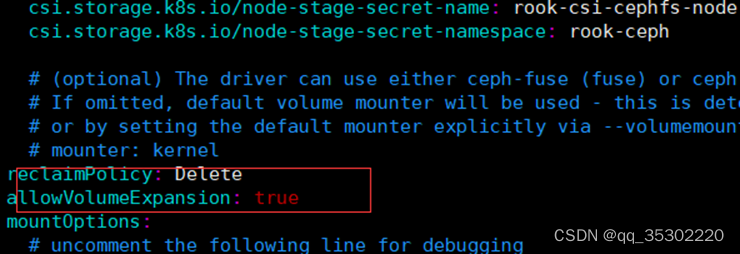
找到第六章创建的pvc:
[root@k8s-master01 cephfs]# kubectl get pvc -n kube-system
NAME STATUS VOLUME CAPACITY ACCESS MODES STORAGECLASS AGE
cephfs-pvc Bound pvc-0149518a-7346-4d16-9030-97b2f9b8e9d2 1Gi RWX rook-cephfs 44m
[root@k8s-master01 cephfs]# kubectl edit pvc cephfs-pvc -n kube-system
将大小修改为2Gi,之前是1Gi

保存退出:
[root@k8s-master01 cephfs]# kubectl edit pvc cephfs-pvc -n kube-system
persistentvolumeclaim/cephfs-pvc edited
查看PV和PVC的大小:
[root@k8s-master01 cephfs]# kubectl get pvc -n kube-system
NAME STATUS VOLUME CAPACITY ACCESS MODES STORAGECLASS AGE
cephfs-pvc Bound pvc-0149518a-7346-4d16-9030-97b2f9b8e9d2 2Gi RWX rook-cephfs 46m
[root@k8s-master01 cephfs]# kubectl get pv
NAME CAPACITY ACCESS MODES RECLAIM POLICY STATUS CLAIM STORAGECLASS REASON AGE
pvc-0149518a-7346-4d16-9030-97b2f9b8e9d2 2Gi RWX Delete Bound kube-system/cephfs-pvc rook-cephfs 47m
pvc-fd8b9860-c0d4-4797-8e1d-1fab880bc9fc 2Gi RWO Delete Bound default/mysql-pv-claim rook-ceph-block 64m
查看容器内是否已经完成扩容:
[root@k8s-master01 cephfs]# kubectl exec -ti kube-registry-66d4c7bf47-46bpq -n kube-system -- df -Th | grep "/var/lib/registry"
ceph 2.0G 0 2.0G 0% /var/lib/registry
同样的步骤可以扩容到3G:

扩容块存储
扩容步骤类似,找到第五章创建PVC,直接edit即可
[root@k8s-master01 cephfs]# kubectl edit pvc mysql-pv-claim
persistentvolumeclaim/mysql-pv-claim edited
[root@k8s-master01 cephfs]# kubectl get pvc
NAME STATUS VOLUME CAPACITY ACCESS MODES STORAGECLASS AGE
mysql-pv-claim Bound pvc-fd8b9860-c0d4-4797-8e1d-1fab880bc9fc 2Gi RWO rook-ceph-block 70m
可以看到此时pvc并没有扩容,但是pv已经扩容:
[root@k8s-master01 cephfs]# kubectl get pv | grep default/mysql-pv-claim
pvc-fd8b9860-c0d4-4797-8e1d-1fab880bc9fc 3Gi RWO Delete Bound default/mysql-pv-claim rook-ceph-block 75m
也可以看到ceph dashboard的image也完成了扩容,但是pvc和pod里面的状态会有延迟,大概等待5-10分钟后,即可完成扩容:

第八章 PVC快照
注意:PVC快照功能需要k8s 1.17+
块存储快照
创建snapshotClass
[root@k8s-master01 rbd]# pwd
/rook/cluster/examples/kubernetes/ceph/csi/rbd
[root@k8s-master01 rbd]# kubectl create -f snapshotclass.yaml
volumesnapshotclass.snapshot.storage.k8s.io/csi-rbdplugin-snapclass created
创建快照
首先在之前创建的MySQL容器里创建一个文件夹,并创建一个文件
[root@k8s-master01 rbd]# kubectl get po
NAME READY STATUS RESTARTS AGE
nginx-6799fc88d8-m5gj5 1/1 Running 1 3d4h
wordpress-mysql-6965fc8cc8-6wt6j 1/1 Running 0 86m
[root@k8s-master01 rbd]# kubectl exec -ti wordpress-mysql-6965fc8cc8-6wt6j -- bash
root@wordpress-mysql-6965fc8cc8-6wt6j:/# ls
bin boot dev docker-entrypoint-initdb.d entrypoint.sh etc home lib lib64 media mnt opt proc root run sbin srv sys tmp usr var
root@wordpress-mysql-6965fc8cc8-6wt6j:/# cd /var/lib/mysql
root@wordpress-mysql-6965fc8cc8-6wt6j:/var/lib/mysql# ls
auto.cnf ib_logfile0 ib_logfile1 ibdata1 lost+found mysql performance_schema
root@wordpress-mysql-6965fc8cc8-6wt6j:/var/lib/mysql# mkdir test_snapshot
root@wordpress-mysql-6965fc8cc8-6wt6j:/var/lib/mysql# ls
auto.cnf ib_logfile0 ib_logfile1 ibdata1 lost+found mysql performance_schema test_snapshot
root@wordpress-mysql-6965fc8cc8-6wt6j:/var/lib/mysql# echo "test for snapshot" > test_snapshot/1.txt
root@wordpress-mysql-6965fc8cc8-6wt6j:/var/lib/mysql# cat test_snapshot/1.txt
test for snapshot
修改snapshot.yaml文件的source pvc为创建的MySQL pvc:

创建快照及查看状态:
[root@k8s-master01 rbd]# kubectl create -f snapshot.yaml
volumesnapshot.snapshot.storage.k8s.io/rbd-pvc-snapshot created
[root@k8s-master01 rbd]# kubectl get volumesnapshotclass
NAME DRIVER DELETIONPOLICY AGE
csi-rbdplugin-snapclass rook-ceph.rbd.csi.ceph.com Delete 8m37s
[root@k8s-master01 rbd]# kubectl get volumesnapshot
NAME READYTOUSE SOURCEPVC SOURCESNAPSHOTCONTENT RESTORESIZE SNAPSHOTCLASS SNAPSHOTCONTENT CREATIONTIME AGE
rbd-pvc-snapshot true mysql-pv-claim 3Gi csi-rbdplugin-snapclass snapcontent-715c2841-d1ba-493a-9eb9-52178df3c2e6 <invalid> <invalid>
指定快照创建PVC
如果想要创建一个具有某个数据的PVC,可以从某个快照恢复:
[root@k8s-master01 rbd]# cat pvc-restore.yaml
---
apiVersion: v1
kind: PersistentVolumeClaim
metadata:
name: rbd-pvc-restore
spec:
storageClassName: rook-ceph-block
dataSource:
name: rbd-pvc-snapshot
kind: VolumeSnapshot
apiGroup: snapshot.storage.k8s.io
accessModes:
- ReadWriteOnce
resources:
requests:
storage: 3Gi
[root@k8s-master01 rbd]# kubectl create -f pvc-restore.yaml
persistentvolumeclaim/rbd-pvc-restore created
注意:dataSource为快照名称,storageClassName为新建pvc的storageClass,storage的大小不能低于原pvc的大小。
[root@k8s-master01 rbd]# kubectl create -f pvc-restore.yaml
persistentvolumeclaim/rbd-pvc-restore created
[root@k8s-master01 rbd]# kubectl get pvc
NAME STATUS VOLUME CAPACITY ACCESS MODES STORAGECLASS AGE
mysql-pv-claim Bound pvc-fd8b9860-c0d4-4797-8e1d-1fab880bc9fc 3Gi RWO rook-ceph-block 95m
rbd-pvc-restore Bound pvc-d86a7535-2331-4fef-ae93-c570c8d3f9e7 3Gi RWO rook-ceph-block 2s
数据校验
创建一个容器,挂载该PVC,查看是否含有之前的文件:
[root@k8s-master01 rbd]# cat restore-check-snapshot-rbd.yaml
---
apiVersion: apps/v1
kind: Deployment
metadata:
name: check-snapshot-restore
spec:
selector:
matchLabels:
app: check
strategy:
type: Recreate
template:
metadata:
labels:
app: check
spec:
containers:
- image: alpine:3.8
name: check
command:
- sh
- -c
- sleep 36000
volumeMounts:
- name: check-mysql-persistent-storage
mountPath: /mnt
volumes:
- name: check-mysql-persistent-storage
persistentVolumeClaim:
claimName: rbd-pvc-restore
[root@k8s-master01 rbd]# kubectl create -f restore-check-snapshot-rbd.yaml
deployment.apps/check-snapshot-restore created
查看数据是否存在
[root@k8s-master01 rbd]# kubectl get po
NAME READY STATUS RESTARTS AGE
check-snapshot-restore-64b85c5f88-zvr62 1/1 Running 0 97s
nginx-6799fc88d8-m5gj5 1/1 Running 1 3d5h
wordpress-mysql-6965fc8cc8-6wt6j 1/1 Running 0 104m
[root@k8s-master01 rbd]# kubectl exec -ti check-snapshot-restore-64b85c5f88-zvr62 -- ls
bin etc lib mnt root sbin sys usr
dev home media proc run srv tmp var
[root@k8s-master01 rbd]# kubectl exec -ti check-snapshot-restore-64b85c5f88-zvr62 -- ls /mnt
auto.cnf ibdata1 performance_schema
ib_logfile0 lost+found test_snapshot
ib_logfile1 mysql
[root@k8s-master01 rbd]# kubectl exec -ti check-snapshot-restore-64b85c5f88-zvr62 -- ls /mnt/test_snapshot
1.txt
[root@k8s-master01 rbd]# kubectl exec -ti check-snapshot-restore-64b85c5f88-zvr62 -- cat /mnt/test_snapshot/1.txt
test for snapshot
测试无误后清理数据(snapshotclass可以不删除,后期创建rbd快照直接用该snapshotclass即可):
[root@k8s-master01 rbd]# kubectl delete -f restore-check-snapshot-rbd.yaml -f pvc-restore.yaml -f snapshot.yaml
deployment.apps "check-snapshot-restore" deleted
persistentvolumeclaim "rbd-pvc-restore" deleted
volumesnapshot.snapshot.storage.k8s.io "rbd-pvc-snapshot" deleted
文件共享类型快照
操作步骤和块存储类型无区别,可以参考:官网
第九章 PVC克隆
[root@k8s-master01 rbd]# pwd
/root/rook/cluster/examples/kubernetes/ceph/csi/rbd
[root@k8s-master01 rbd]# cat pvc-clone.yaml
---
apiVersion: v1
kind: PersistentVolumeClaim
metadata:
name: rbd-pvc-clone
spec:
storageClassName: rook-ceph-block
dataSource:
name: mysql-pv-claim
kind: PersistentVolumeClaim
accessModes:
- ReadWriteOnce
resources:
requests:
storage: 3Gi
[root@k8s-master01 rbd]# kubectl create -f pvc-clone.yaml
persistentvolumeclaim/rbd-pvc-clone created
[root@k8s-master01 rbd]# kubectl get pvc
NAME STATUS VOLUME CAPACITY ACCESS MODES STORAGECLASS AGE
mysql-pv-claim Bound pvc-fd8b9860-c0d4-4797-8e1d-1fab880bc9fc 3Gi RWO rook-ceph-block 110m
rbd-pvc-clone Bound pvc-6dda14c9-9d98-41e6-9d92-9d4ea382c614 3Gi RWO rook-ceph-block 4s
需要注意的是pvc-clone.yaml的dataSource的name是被克隆的pvc名称,在此是mysql-pv-claim,storageClassName为新建pvc的storageClass名称,storage不能小于之前pvc的大小。
第十章 测试数据清理
如果Rook要继续使用,可以只清理创建的deploy、pod、pvc即可。之后可以直接投入使用
数据清理步骤:
-
首先清理挂载了PVC和Pod,可能需要清理单独创建的Pod和Deployment或者是其他的高级资源
-
之后清理PVC,清理掉所有通过ceph StorageClass创建的PVC后,最好检查下PV是否被清理
-
之后清理快照:kubectl delete volumesnapshot XXXXXXXX
-
之后清理创建的Pool,包括块存储和文件存储
a) kubectl delete -n rook-ceph cephblockpool replicapool
b) kubectl delete -n rook-ceph cephfilesystem myfs
-
清理StorageClass:kubectl delete sc rook-ceph-block rook-cephfs
-
清理Ceph集群:kubectl -n rook-ceph delete cephcluster rook-ceph
-
删除Rook资源:
a) kubectl delete -f operator.yaml
b) kubectl delete -f common.yaml
c) kubectl delete -f crds.yaml
-
如果卡住需要参考Rook的troubleshooting
a) https://rook.io/docs/rook/v1.6/ceph-teardown.html#troubleshooting
for CRD in $(kubectl get crd -n rook-ceph | awk '/ceph.rook.io/ {print $1}'); do kubectl get -n rook-ceph "$CRD" -o name | xargs -I {} kubectl patch {} --type merge -p '{"metadata":{"finalizers": [null]}}' -n rook-ceph; done
- 清理数据目录和磁盘
参考链接:https://rook.io/docs/rook/v1.6/ceph-teardown.html